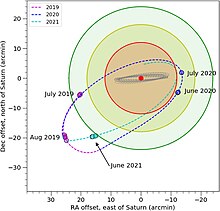 S/2019 S 1 on the day of its discovery, revealed by stacking multiple images to its motion S/2019 S 1 on the day of its discovery, revealed by stacking multiple images to its motion | |
| Discovery | |
|---|---|
| Discovered by | E. Ashton et al. |
| Discovery date | 2019 (announced 2021) |
| Designations | |
| Alternative names | e26r58a12 |
| Orbital characteristics | |
| Semi-major axis | 11221100 km |
| Eccentricity | 0.623 |
| Orbital period (sidereal) | 443.78 days |
| Inclination | 44.4° |
| Satellite of | Saturn |
| Group | Inuit group (Kiviuq) |
| Physical characteristics | |
| Mean diameter | 5+30% −15% km |
| Albedo | 0.06 (assumed) |
| Apparent magnitude | 25.3 |
| Absolute magnitude (H) | 15.3 |
S/2019 S 1 is a natural satellite of Saturn. Its discovery was announced by Edward Ashton, Brett J. Gladman, Jean-Marc Petit, and Mike Alexandersen on 16 November 2021 from Canada–France–Hawaii Telescope observations taken between 1 July 2019 and 14 June 2021.

S/2019 S 1 is about 5 kilometres in diameter, and orbits Saturn at an average distance of 11.2 million km (7.0 million mi) in 443.78 days, at an inclination of 44° to the ecliptic, in a prograde direction and with an eccentricity of 0.623. It belongs to the Inuit group of prograde irregular satellites, and is among the innermost irregular satellites of Saturn. It might be a collisional fragment of Kiviuq and Ijiraq, which share very similar orbital elements.
This moon's eccentric orbit takes it closer than 1.5 million km (0.93 million mi) to Iapetus several times per millennium.
References
- ^ "MPEC 2021-W14 : S/2019 S 1". minorplanetcenter.net. Retrieved 16 November 2021.
- ^ Ashton, Edward; Gladman, Brett; Beaudoin, Matthew; Alexandersen, Mike; Petit, Jean-Marc (May 2022). "Discovery of the Closest Saturnian Irregular Moon, S/2019 S 1, and Implications for the Direct/Retrograde Satellite Ratio". The Astronomical Journal. 3 (5): 5. Bibcode:2022PSJ.....3..107A. doi:10.3847/PSJ/ac64a2. S2CID 248771843. 107.
- ^ Ashton, Edward; Gladman, Brett; Beaudoin, Matthew; Alexandersen, Mike; Petit, Jean-Marc (October 2021). Detection biases favour retrograde over direct irregular moons. 53rd Annual DPS Meeting. American Astronomical Society. 308.09. Retrieved 17 November 2021.
- ^ "S/2019 S 1 – Tilmann Denk".
| Moons of Saturn | |||||||
|---|---|---|---|---|---|---|---|
| Listed in approximate increasing distance from Saturn | |||||||
| Ring moonlets | |||||||
| Ring shepherds | |||||||
| Other inner moons | |||||||
| Alkyonides | |||||||
| Large moons (with trojans) | |||||||
| Inuit group (13) |
| ||||||
| Gallic group (7) | |||||||
| Norse group (100) |
| ||||||
| Outlier prograde irregular moons |
| ||||||
| Saturn | |
|---|---|
| Geography | |
| Moons | |
| Astronomy | |
| Exploration | |
| Related | |
This article related to a natural satellite is a stub. You can help Misplaced Pages by expanding it. |